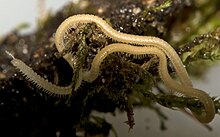Siphonorhinidae
| Siphonophorida | |
|---|---|
 |
|
| Illacme plenipes | |
| Scientific classification | |
| Kingdom: | Animalia |
| Phylum: | Arthropoda |
| Class: | Diplopoda |
| Subclass: | Chilognatha |
| Infraclass: | Helminthomorpha |
| Order: |
Siphonophorida Newport, 1844 |
| Families | |
| Synonyms | |
|
Californizoniinae Verhoeff, 1941 |
|
Siphonophoridae
Siphonorhinidae
Californizoniinae Verhoeff, 1941
Siphonophorida (Greek for "tube bearer") is an order of millipedes containing two families and over 100 species. This order includes the millipede with the most legs, Illacme plenipes.
Millipedes in the order Siphonophorida are long and worm-like, reaching up to 36 millimetres (1.4 in) in length and up to 190 body segments. Eyes are absent, and in many species the head is elongated into a long beak, with mandibles highly reduced. The beak may serve in a suctorial function. The body has a dense covering of fine setae. Each body segment consists of a dorsal tergite, two lateral pleurites, and ventral sternite, which are unfused. The male reproductive appendages (gonopods) are simple and leg-like, consisting of the ninth and 10th leg pairs. This lack of specialization has led to Siphonophorida being called a "taxonomist's nightmare", and Jeekel (cited in) jokingly gave the order the "taxonomists' award for least popular group among diplopods".
Siphonophorida occurs from southwestern USA to Brazil and Peru in the western hemisphere, as well as South Africa, India, southeast Asia and Australia.
Two families are traditionally recognized. Differences between the two families include antennae and head structure: the large family Siphonophoridae, with over 100 species, has elongate beak-like mouthparts, and straight antennae with sensory pits on the fifth and sixth antennal segments ("antennomeres)". The family Siphonorhinidae, with only around 10 species, lacks the beak-like mouthparts, and has elbowed antennae lacking sensory pits on the fifth and sixth antennomere. The siphonorhinid genus Nematozonium with two species, is sometimes placed in its own monotypic family, Nematozoniidae.
...
Wikipedia
